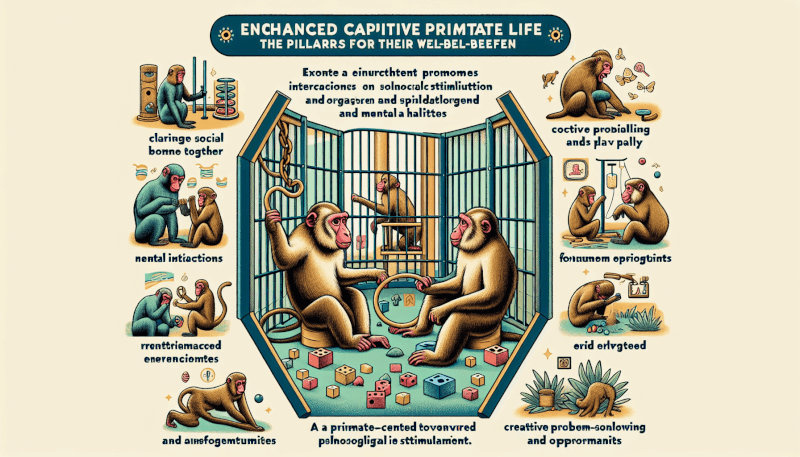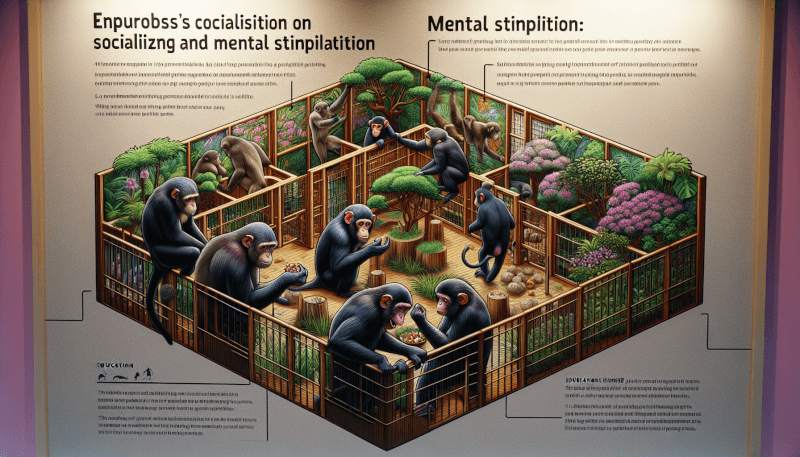Are you curious about how to improve the social lives of captive primates? Look no further! In this article, we will explore a variety of strategies that can be implemented to enhance the social well-being of these intelligent creatures. By providing them with engaging environments and opportunities for social interaction, we can help alleviate the stress and boredom that often accompany captivity. Join us as we delve into the fascinating world of captive primate socialization and uncover ways to promote a happier and healthier existence for these incredible animals.

Social Group Formation
One of the most important strategies for enriching the social lives of captive primates is to carefully consider the formation of social groups. Primates are highly social animals, and they thrive in environments where they can interact and form meaningful relationships with others of their species. When creating social groups, it is crucial to consider factors such as age, sex, and social dynamics.
By carefully selecting primate individuals that are compatible with each other, we can create social groups that promote positive social interactions and reduce the risk of aggression or stress. It is essential to consider the natural social structure of the specific primate species and strive to recreate it as closely as possible in a captive environment.
Creating a Species-Specific Environment
To further enhance the social lives of captive primates, it is essential to provide them with an environment that is as close to their natural habitat as possible. This includes replicating their native climate, vegetation, and structural elements such as trees and branches. By recreating a species-specific environment, we can encourage natural behaviors and facilitate social interactions among the primates.
Creating a species-specific environment also involves providing appropriate social structures such as platforms, hammocks, and climbing frames where primates can engage in social activities and establish hierarchies. These structures mimic the natural habitat of primates and provide opportunities for them to interact, play, and bond with one another.

Providing Opportunities for Socializing
Captive primates, like their wild counterparts, need ample opportunities for socializing with other members of their species. Enclosures should be designed in a way that allows for ample space for group activities and social interactions. The inclusion of features such as perches, play structures, and grooming stations can further encourage social behavior and facilitate positive interactions.
Additionally, it is crucial to provide regular opportunities for captive primates to engage in social activities outside of their enclosures. This may include supervised play sessions, socialization periods, or even the creation of larger communal spaces where multiple social groups can interact. By providing these opportunities, we can ensure that captive primates are able to engage in natural social behaviors and maintain a sense of community.
Establishing a Dominance Hierarchy
In the wild, many primate species live in social groups that have a clear dominance hierarchy. This hierarchy helps to regulate social interactions and maintain order within the group. When designing social groups for captive primates, it is important to establish a similar dominance hierarchy that allows individuals to understand their place within the group.
By establishing a dominance hierarchy, we can minimize aggression and reduce the risk of social conflict within captive primate communities. This can be achieved through careful observation and monitoring of individual behaviors, as well as providing opportunities for individuals to establish their dominance through non-aggressive interactions such as grooming and play.

Encouraging Natural Behaviors
One of the key aspects of enriching the social lives of captive primates is encouraging natural behaviors. Primates have a diverse range of natural behaviors, including grooming, play, foraging, and vocalizations. It is crucial to provide opportunities for captive primates to engage in these behaviors, as they serve as important forms of social communication and social bonding.
Enrichment activities that promote natural behaviors can include the provision of puzzle feeders, foraging opportunities, and access to natural materials such as branches or leaves. By incorporating these elements into their daily routines, we can stimulate their minds and promote a sense of natural engagement, leading to increased socialization and improved overall well-being.
Implementing Socialization Programs
To further enhance the social lives of captive primates, the implementation of socialization programs can be highly beneficial. These programs can involve carefully supervised introductions between individuals, gradual integration into existing social groups, or the formation of new social groups altogether. The goal is to provide captive primates with the opportunity to form new social bonds and expand their social networks.
Socialization programs should be conducted under the supervision of experienced professionals and follow a carefully planned and monitored approach. Individual assessments, gradual introductions, and frequent evaluations should be conducted to ensure the well-being and safety of all primates involved. These programs can be a crucial tool in promoting social interactions and enriching the lives of captive primates.

Promoting Positive Interactions
In order to foster positive social interactions among captive primates, it is important to provide a supportive and enriching environment. This includes ensuring that there are ample resources available, such as food, water, and resting areas, to minimize competition and potential conflict. Balancing the social dynamics within a group is crucial to creating a harmonious and thriving primate society.
Additionally, it is important to provide opportunities for positive interactions, such as group activities, shared feeding times, and grooming sessions. These activities help to build social bonds, strengthen relationships, and promote a sense of community within the captive primate group. A positive and enriched social environment is essential for the overall well-being and happiness of captive primates.
Considering Individual Needs
While it is important to create social groups for captive primates, it is equally important to consider the individual needs of each primate. Some primates may thrive in large social groups, while others may prefer smaller, more intimate social interactions. By taking into account the individual personalities, preferences, and social behaviors of each primate, we can tailor their social environment to best meet their needs.
Individual assessment and observation should be conducted regularly to ensure that individuals are adjusting well to their social groups and are not experiencing stress or social isolation. Adjustments may need to be made in terms of group composition, social dynamics, or the provision of additional socialization opportunities to ensure the overall well-being of each primate.

Implementing Intergenerational Socialization
Intergenerational socialization is a strategy that involves mixing individuals of different age groups within social groups. This strategy can be highly enriching for captive primates, as it allows for the transfer of knowledge, socialization skills, and behaviors from older, more experienced individuals to younger ones. It also promotes a sense of social cohesion and provides opportunities for nurturing and mentorship.
By implementing intergenerational socialization, we can create a more diverse and dynamic social environment for captive primates. Younger individuals can learn important social skills from older individuals, while older individuals can benefit from the presence of younger individuals, fostering a sense of purpose and continued engagement within the group.
Monitoring and Assessing Socialization Efforts
Finally, it is crucial to continually monitor and assess the socialization efforts within captive primate communities. Regular observations, behavioral assessments, and social interaction analyses should be conducted to ensure that social groups are functioning harmoniously and that individuals are benefiting from their social interactions.
Any signs of aggression, stress, or social disturbance should be addressed promptly and appropriate measures should be taken to rectify the situation. Socialization efforts should be flexible and adaptable to the changing dynamics and needs of the social groups. By continually monitoring and assessing socialization efforts, we can identify areas for improvement and ensure the ongoing enrichment of captive primate social lives.
In conclusion, enhancing the social lives of captive primates is crucial for their overall well-being and happiness. By carefully considering social group formation, creating a species-specific environment, providing opportunities for socializing, establishing a dominance hierarchy, encouraging natural behaviors, implementing socialization programs, promoting positive interactions, considering individual needs, implementing intergenerational socialization, and monitoring and assessing socialization efforts, we can create enriching and fulfilling social environments for captive primates. These strategies not only improve the lives of the primates themselves but also contribute to our understanding and conservation efforts for these remarkable animals.


